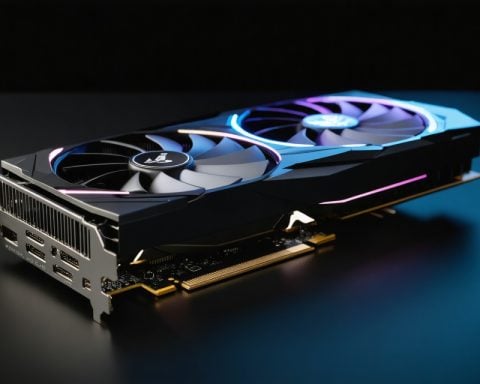- Nvidia’s resilience shines as its shares rebound to $139.40, recovering from recent market turbulence.
- Elon Musk’s xAI unveils Grok 3, a groundbreaking AI development, contributing to Nvidia’s stock recovery.
- South Korea commits to purchasing 10,000 Nvidia GPUs, advancing toward an elite AI infrastructure.
- The acquisition includes Nvidia’s high-performance H100 and H200 models, highlighting strong demand.
- Analysts note “buoyant cloud GPU pricing,” bolstering Nvidia’s market position.
- Nvidia’s adaptability and strategic partnerships emphasize its growth potential amid industry challenges.
Volatile winds buffeted Nvidia, the chip titan, but the tempest has calmed with a dazzling twist. Battling fierce headwinds after DeepSeek’s audacious launch — a move that sent semiconductor stocks tumbling perilously — Nvidia emerges by the daybreak, almost unscathed.
This week, Nvidia’s shares nearly bounced back from their staggering plunge, closing at $139.40 after a nimble 0.40% lift. This resurgence was sparked by the unveiling of Grok 3, a cutting-edge AI marvel by Elon Musk’s xAI, as well as an unexpected triumph in South Korea.
Amidst a tapestry of visionary ambitions, South Korea pledges to transform its technological landscape. The nation announced plans to procure a staggering ensemble of 10,000 GPUs from Nvidia, a crucial stride toward crafting an advanced national AI computing hub. With horizon-spanning vision, President Choi Sang-mok orchestrates this leap, driving South Korea toward a place among the global AI elite.
The deal encompasses the powerhouse H100 and H200 models. This acquisition underscores the surging demand and affirms the robust allure of Nvidia’s technological prowess. As textual whispers of “buoyant cloud GPU pricing” echo in analyst discussions, hope dances anew for Nvidia, promising a fortification of resilience against the competitive onslaught.
The key takeaway? In the intricate dance of technological empires, adaptability reigns supreme. Seizing opportunities and forging alliances are the harbingers of recovery and growth amid the relentless churn of innovation. Nvidia’s saga illustrates the unyielding potential to thrive, even against formidable challenges.
Nvidia’s Resilient Rise and the Potential Impact of South Korea’s AI Expansion
Industry Overview: Nvidia’s Strategic Position
Nvidia Corporation stands as a titan in the semiconductor industry, primarily driven by its innovative GPU technology, pivotal for AI development, gaming, and data processing. In recent months, Nvidia faced considerable volatility, yet it has demonstrated resilience, largely due to strategic moves and external collaborations that highlight its adaptability and influence in the tech world.
Deep Dive into South Korea’s Ambitious AI Agenda
How-To Steps & Life Hacks: Building a National AI Infrastructure
1. Assess Current Technological Infrastructure:
South Korea’s move to acquire 10,000 GPUs from Nvidia showcases the importance of evaluating existing capabilities before scaling AI infrastructure.
2. Strategic Partnerships:
Partnering with established tech giants like Nvidia ensures access to cutting-edge technology and expertise.
3. Government Initiatives and Funding:
Allocating national budget toward AI and tech improvements can accelerate technological leaps.
4. Workforce Development:
Training programs to ensure the workforce is equipped with necessary AI skills is crucial.
5. Regulatory and Ethical Framework:
Implement policies to govern AI use, emphasizing ethical considerations and data privacy.
Market Forecasts & Industry Trends
Nvidia’s Position in the Global Market
– GPUs Demand Surge: The demand for GPUs is set to increase with the acceleration of AI, machine learning, and big data analytics globally.
– AI Advancements and Innovation: As reported by Gartner, AI will continue to drive tech investments, with a forecasted market growth of AI-generated business value projected to reach USD 3.5 trillion by 2025.
– Emerging Markets: South Korea’s AI push exemplifies a trend where emerging markets invest heavily in AI, recognizing its transformative economic impact.
Reviews & Comparisons: Nvidia’s Products
H100 and H200 GPUs
– Performance: Known for providing exceptional AI processing power, Nvidia’s H100 and H200 GPUs are optimized for deep learning and complex computations.
– Comparison to Competitors: Compared to rivals like AMD’s Instinct GPUs, Nvidia’s solutions are often preferred for their CUDA architecture, which offers broader support for software applications and frameworks.
Controversies & Limitations
Concerns in the AI Ecosystem
– Resource Intensity: Nvidia’s GPUs require significant energy, raising sustainability concerns discussed in global forums.
– Market Monopoly: Some industry critics highlight risks associated with Nvidia’s dominant position in AI GPU markets, emphasizing the need for diverse tech ecosystems.
Features, Specs & Pricing
Specifications:
– H100 GPUs: Tailored for enterprise AI with performance enhancements in data throughput.
– H200 GPUs: Designed for optimal energy efficiency and advanced bandwidth capabilities, enhancing cloud computing solutions.
Actionable Recommendations
1. Stay Informed: Regularly follow industry trends and announcements from Nvidia and other market leaders.
2. Invest in Skills Development: Engage in training or certification programs in AI and data analytics.
3. Explore Partnerships: For businesses, collaborations with tech leaders can lead to access to cutting-edge solutions and R&D resources.
Overall, Nvidia exemplifies how strategic adaptability and international partnerships can effectively counteract market volatility and propel growth. For readers keen on AI sector advancements, keeping an eye on developments in regions like South Korea can offer insights into the future landscape.
Quick Tips:
– For Investors: Monitor Nvidia’s quarterly earnings and market reactions to announcements from allied sectors.
– For IT Professionals: Gain proficiency in Nvidia’s CUDA and other AI-enhancing technologies as they become vital for tech development worldwide.


















